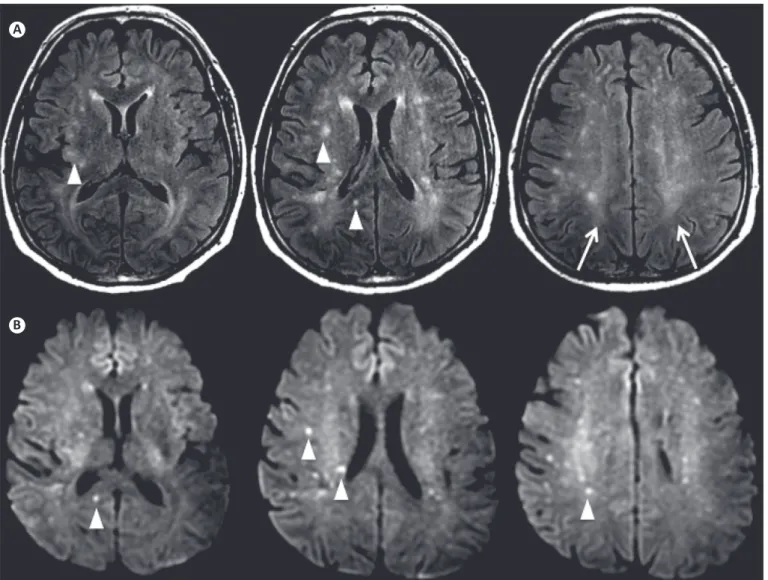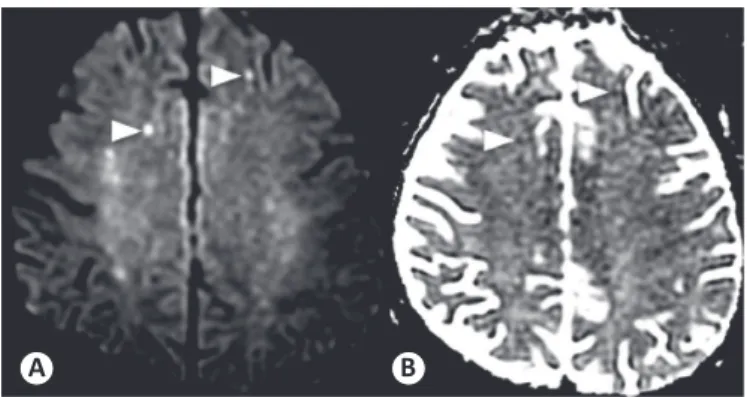413
Rev Soc Bras Med Trop 50(3):413-416, May-june, 2017 doi: 10.1590/0037-8682-0449-2016
Case Report
Encephalitis associated with the chikungunya epidemic
outbreak in Brazil: report of 2 cases with
neuroimaging indings
Licia Pacheco Pereira
[1],[2], Rafaela Villas-Bôas
[2], Stephanie Suzanne de Oliveira Scott
[3],
Paulo Ribeiro Nóbrega
[3], Manoel Alves Sobreira-Neto
[3],
José Daniel Vieira de Castro
[1], Bruno Cavalcante
[4]and Pedro Braga-Neto
[3][1]. Divisão de Neurorradiologia, Departamento de Radiologia, Hospital Universitário Walter Cantídio, Universidade Federal do Ceará, Fortaleza, CE, Brasil. [2]. Departamento de Radiologia, Hospital Geral de Fortaleza, Fortaleza, CE, Brasil.
[3]. Divisão de Neurologia, Departamento de Medicina Clínica, Hospital Universitário Walter Cantídio, Universidade Federal do Ceará, Fortaleza, CE, Brazil. [4]. Departamento de Medicina Clínica, Hospital Monte Klinikum, Fortaleza, CE, Brasil.
Abstract
Chikungunya, an alphavirus infection presenting with fever, rash, and polyarthritis, is most often an acute febrile illness. Neurologic complications of chikungunya infection have been reported. Here we report the clinical and neuroimaging data of 2 patients with chikungunya-associated encephalitis during the recent Brazilian epidemic.
Keywords: Chikungunya virus. Encephalitis. MRI.
Corresponding author: Dra. Licia Pacheco Pereira.
e-mail: liciap.luna@gmail.com
Received 31 October 2016
Accepted 25 January 2017
INTRODUCTION
Chikungunya fever (CF) is caused by an arthropod-borne alphavirus that belongs to the Togaviridae family and is transmitted by Aedes mosquitoes1. Chikungunya virus (CHIKV)
was irst isolated in 1952-1953, during an epidemic in East
Africa. The term chikungunya is derived from the Makonde language (spoken in some areas of Mozambique and Tanzania), which means that which bends up, referring to the stooped posture due to the severe arthralgias it causes1. Other symptoms
such as high fever, headaches, nausea, and vomiting may also occur1. An increase in the frequency of outbreaks caused by
this arbovirus has been observed since 2005, when more than 240,000 people were infected and 203 deaths occurred in the French island of Reunion1, followed by a worldwide spread.
Since its irst description, the virus has been identiied in 60
countries2.
The irst report of local transmission in Brazil occurred
in 2014 in the City of Oiapoque, Amapá3 and in 2016, it
was estimated that the CHIKV is circulating in almost half of Brazilian cities2. Only in the irst half of this year, Brazil
recorded 170,000 cases of CHIKV disease ̶ 10 times the
number seen in the same period in 20154 ̶ and the country
now accounts for 94% of conirmed cases of the disease in the
Americas5. In Brazil, CHIKV is transmitted by Aedes aegypti,
the same mosquito that carries the Zika virus (ZIKV), which has been declared a public health emergency in Brazil, as well as dengue fever.
According to a recent meta-analysis, up to 40% of patients
may have chronic complications, mainly arthritis2,6, and severe
or fatal forms of the disease with CNS involvement have been observed, in both adults and neonates2,7.
Herein we describe two adult cases of CHIKV-associated central nervous system (CNS) disease during the Brazilian
outbreak with emphasis on imaging indings. To the best of our knowledge, these are the irst CNS imaging reports since the
arrival of CHIKV into the country.
CASE REPORTS
Case 1
414
Pereira LP, et al. - Chikungunya-associated encephalitis: case reports and neuroimaging indings
FIGURE 1 - Multiple supratentorial FLAIR (A) and DWI (B) hyperintense foci (arrowheads) distributed randomly in the white matter. Diffuse FLAIR hyperintense white matter was also noted on the centrum semiovale (arrows in A). FLAIR: Fluid-attenuated inversion recovery; DWI: Diffusion weighted imaging.
A
B
(with moments of apnea). Lung auscultation was normal. His
abdomen was laccid, not tender and without organomegaly.
There was no evidence of arthropathy. The neurological examination showed inattention and disorientation in time and
space. No focal deicits or pathological relexes were found,
and he had no cranial nerve abnormalities. Cerebrospinal
luid (CSF) analysis showed an increase in white cells with
a predominance of lymphocytes [white blood cell count of 61 cells/mm3 (lymphocytes 71%)], no red blood cells, CSF
glucose of 62mg/dL, and CSF protein of 98mg/dL. CSF gram
and fungal stains, as well as bacterial cultures, were negative. Immunoglobulin M (IgM) for dengue, cytomegalovirus, Epstein-Barr virus, and toxoplasmosis, as well as blood cultures, yielded negative results. Seroconversion to CHIKV was
conirmed on enzyme-linked immunosorbent assay (ELISA) by the presence of IgM antibodies [reactivity = 3.9 (reference
> 1.1)]. Magnetic resonance imaging (MRI) with contrast
showed bilateral supratentorial white matter luid-attenuated
inversion recovery (FLAIR) and diffusion-weighted imaging
(DWI) hyperintensities (Figure 1), with some of the cortical and subcortical foci showing restricted water diffusion on the
apparent diffusion coeficient (ADC) map (Figure 2). There was no specific predominance, and no leptomeningeal or parenchymal enhancement was noticed. There was also mild cortical atrophy (global cortical atrophy scale - 1). There were no signs of cranial nerve involvement. An MRI scan with contrast of the spinal cord was normal. His CSF was tested via reverse transcription-polymerase chain reaction (RT-PCR) for CHIKV ribonucleic acid (RNA) and yielded negative results. On the 5th
415 Rev Soc Bras Med Trop 50(3):413-416, May-june, 2017
FIGURE 2 - The cortical and subcortical hyperintense foci (arrowheads) in DWI (A) show restricted water diffusion seen as hypointense areas on the ADC map (B). DWI: Diffusion weighted imaging; ADC: Apparent diffusion coeficient.
A B
Case 2
A 74-year-old male patient, a native of Morada Nova, Northeastern Brazil, previously healthy and with no cognitive
deicits, presented with a 4-day history of fever, maculopapular
rash, and severe arthralgia. Four days after the onset of
symptoms he presented with confusion and luctuating level
of consciousness, leading to hospitalization. On admission, the patient was somnolent, however responsive, with temporal and spatial disorientation. The CSF study showed an increase in white cells with a predominance of lymphocytes (leukocytes:
90/mm3; 91% lymphocytes) and increased protein (179mg/dL).
The patient developed progressive lower limb weakness (an initial grade 3 power in the lower limbs, progressing rapidly to
grade 0 after 5 days) and diffuse arelexia. There was no clear
sensory level or bladder dysfunction and there were also no signs of cranial nerve or cerebellar lesions. Anti-chikungunya IgM was found in serum. The electroencephalogram showed disorganized electrical brain activity with the presence of triphasic waves, and the nerve conduction study (NCS)/electromyography (EMG) displayed sensorimotor axonal neuropathy. Sequential brain MRI exams showed the appearance of multiple bilateral FLAIR and DWI hyperintense foci with restricted water diffusion in the supratentorial white matter (Figure 3). An MRI scan with contrast of the spinal cord was normal. After receiving intravenous immunoglobulin (400mg/kg/day) for 5 days, she recovered quickly. Brain MRI four months later demonstrated persistent, but reduced hyperintense foci on FLAIR, which were absent on DWI.
A B C
416
DISCUSSION
The diagnosis of encephalitis was based on the clinical
presentation, laboratory CSF results, and MRI indings. CSF
examinations showed elevated protein with mild pleocytosis and lymphocyte predominance, typically seen in viral encephalitis. Both patients tested positive for anti-chikungunya IgM in their serum. Although genomic products in CSF were negative in case 1, this was not surprising, given the brief period (4-5 days) of viremia8. Both patients were infected during a recent epidemic in an endemic zone in the Northeast region of Brazil.
Our findings are consistent with earlier reports of CNS complications of CHIKV infection, ranging from mild neurocognitive or behavioral disorders to severe neurologic syndromes including acute encephalitis/encephalopathy, acute disseminated encephalomyelitis (ADEM) and Guillain-Barré syndrome7,9. Our patients had different clinical presentations, the
irst case being a mild encephalopathy with a good response to
steroids. On the other hand, the second patient had a more severe neurological disease involving signs of encephalitis and an acute
laccid weakness with an axonal pattern in EMG and NCS and
CSF pleocytosis with high protein content. This second pattern has been described previously in some arbovirosis, particularly the one
caused by West Nile virus. These indings underscore the varied
presentations of neurological symptoms in chikungunya fever.
The neuroimaging indings were bilateral predominantly
frontoparietal white matter lesions with increased signal on DWI, which is described as an early sign of viral encephalitis10.
These indings are similar to the cases of CHIKV-associated
encephalitis reported by Ganesan et al. in India11. However,
these authors reported nodular enhancement in some of the lesions with restricted diffusion in one of the cases, which was not seen here. Moreover, Case 2. presented with clinical signs of polyradiculitis. Myeloradiculitis was reported by Ganesan et al., depicted on spine MRI scan as a cauda equina nerve root
enhancement ̶ also not present here.
Bilateral white matter lesions with restricted diffusion due to cytotoxic edema may be secondary to plasma leakage from capillaries and venules, which can occur in vasculitis or acute demyelination induced by sensitization to viral antigen and microglial activation11. Restricted diffusion precedes signal
abnormalities seen on FLAIR images and is also known to resolve earlier than the FLAIR signal abnormalities during the recovery period, as seen in Case 2. In the cases reported here, given the MR-DWI abnormalities, cerebral vasculitis and autoimmune encephalitis were differential diagnoses. However, the acute clinical presentation and the benign course did not support either of these diagnoses. In addition, the resolution of the DWI lesions and radiologic lack of disease activity at 3 months rarely occurs in either of these diseases.
This report highlights the clinicoradiologic indings in
patients with encephalitis following chikungunya infection in the recent Brazilian epidemic. From an imaging perspective, a careful analysis of DWI is essential for the diagnosis of CHIKV-associated encephalitis since it can easily be interpreted as
unspeciic indings on FLAIR images, such as age-related white
matter changes, and clinical correlation is necessary.
Acknowledgments
We offer our deepest thanks to Dr. Francisco Ronald Pedrosa de Oliveira Junior for his important support and help in providing the clinical information about one of the patients reported here.
Conlict of interest
The authors declare that have no conlicts of interest.
REFERENCES
1. Kucharz EJ, Cebula-Byrska I. Chikungunya fever. Eur J Intern Med. 2012;23(4):325-9.
2. Collucci C. Brazil sees sharp rise in chikungunya cases. BMJ. 2016;354:i4560.
3. Lima-Camara TN. Emerging arboviruses and public health challenges in Brazil. Rev Saude Publica. 2016;50:36. doi: 10.1590/ S1518-8787.2016050006791
4. Ministério da Saúde (MS). 2016. Boletim epidemioĺgico. Brasília: Secretaria de Vigilância em Saúde; 2016.
5. Pan American Health Organization. World Health Organization (PAHO WHO). Chikungunya: PAHO/WHO Data, Maps and Statistics. 2016.
6. Rodriguez-Morales AJ, Cardona-Ospina JA, Urbano-Garzon SF, Hurtado-Zapata JS. Prevalence of post-Chikungunya infection chronic inlammatory arthritis: a systematic review and meta-analysis. Arthritis Care Res. 2016;68(12):1849-58.
7. Gérardin P, Couderc T, Bintner M, Tournebize P, Renouil M, Lémant J, et al. Chikungunya virus-associated encephalitis: a cohort study on La Réunion Island, 2005-2009. Neurology. 2016;86(1):94-102. 8. DeBiasi RL, Tyler KL. Molecular methods for diagnosis of viral
encephalitis. Clin Microbiol Rev. 2004;17(4):903-25.
9. Lebrun G, Chadda K, Reboux AH, Martinet O, Gaüzère BA. Guillain-Barré syndrome after Chikungunya infection. Emerg Infect Dis. 2009;15(3):495-6.
10. Nouranifar RK, Ali M, Nath J. The earliest manifestation of focal encephalitis on diffusion-weighted MRI. Clin Imaging. 2003;27(5):316-20.
11. Ganesan K, Diwan A, Shankar SK, Desai SB, Sainani GS, Katrak SM. Chikungunya encephalomyeloradiculitis: report of 2 cases with neuroimaging and 1 case with autopsy indings. AJNR Am J Neuroradiol. 2008;29(9):1636-7.

